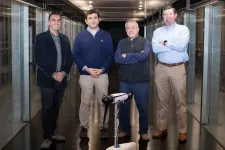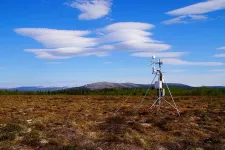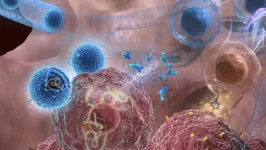(Press-News.org) CAMBRIDGE, MA — A simple technique that uses small amounts of energy could boost the efficiency of some key chemical processing reactions, by up to a factor of 100,000, MIT researchers report. These reactions are at the heart of petrochemical processing, pharmaceutical manufacturing, and many other industrial chemical processes.
The surprising findings are reported today in the journal Science, in a paper by MIT graduate student Karl Westendorff, professors Yogesh Surendranath and Yuriy Roman-Leshkov, and two others.
“The results are really striking,” says Surendranath, a professor of chemistry and chemical engineering. Rate increases of that magnitude have been seen before but in a different class of catalytic reactions known as redox half-reactions, which involve the gain or loss of an electron. The dramatically increased rates reported in the new study “have never been observed for reactions that don’t involve oxidation or reduction,” he says.
The non-redox chemical reactions studied by the MIT team are catalyzed by acids. “If you’re a first-year chemistry student, probably the first type of catalyst you learn about is an acid catalyst,” Surendranath says. There are many hundreds of such acid-catalyzed reactions, “and they’re super important in everything from processing petrochemical feedstocks to making commodity chemicals to doing transformations in pharmaceutical products. The list goes on and on.”
“These reactions are key to making many products we use daily,” adds Roman-Leshkov, a professor of chemical engineering and chemistry.
But the people who study redox half-reactions, also known as electrochemical reactions, are part of an entirely different research community than those studying non-redox chemical reactions, known as thermochemical reactions. As a result, even though the technique used in the new study, which involves applying a small external voltage, was well-known in the electrochemical research community, it had not been systematically applied to acid-catalyzed thermochemical reactions.
People working on thermochemical catalysis, Surendranath says, “usually don’t consider” the role of the electrochemical potential at the catalyst surface, “and they often don’t have good ways of measuring it. And what this study tells us is that relatively small changes, on the order of a few hundred millivolts, can have huge impacts — orders of magnitude changes in the rates of catalyzed reactions at those surfaces.”
“This overlooked parameter of surface potential is something we should pay a lot of attention to because it can have a really, really outsized effect,” he says. “It changes the paradigm of how we think about catalysis.”
Chemists traditionally think about surface catalysis based on the chemical binding energy of molecules to active sites on the surface, which influences the amount of energy needed for the reaction, he says. But the new findings show that the electrostatic environment is “equally important in defining the rate of the reaction.”
The team has already filed a provisional patent application on parts of the process and is working on ways to apply the findings to specific chemical processes. Westendorff says their findings suggest that “we should design and develop different types of reactors to take advantage of this sort of strategy. And we’re working right now on scaling up these systems.”
While their experiments so far were done with a two-dimensional planar electrode, most industrial reactions are run in three-dimensional vessels filled with powders. Catalysts are distributed through those powders, providing a lot more surface area for the reactions to take place. “We’re looking at how catalysis is currently done in industry and how we can design systems that take advantage of the already existing infrastructure,” Westendorff says.
Surendranath adds that these new findings “raise tantalizing possibilities: Is this a more general phenomenon? Does electrochemical potential play a key role in other reaction classes as well? In our mind, this reshapes how we think about designing catalysts and promoting their reactivity.”
Roman-Leshkov adds that “traditionally people who work in thermochemical catalysis would not associate these reactions with electrochemical processes at all. However, introducing this perspective to the community will redefine how we can integrate electrochemical characteristics into thermochemical catalysis. It will have a big impact on the community in general.”
While there has typically been little interaction between electrochemical and thermochemical catalysis researchers, Surendranath says, “this study shows the community that there’s really a blurring of the line between the two, and that there is a huge opportunity in cross-fertilization between these two communities.”
Westerndorff adds that to make it work, “you have to design a system that’s pretty unconventional to either community to isolate this effect.” And that helps explain why such a dramatic effect had never been seen before. He notes that even their paper’s editor asked them why this effect hadn’t been reported before. The answer has to do with “how disparate those two ideologies were before this,” he says. “It’s not just that people don’t really talk to each other. There are deep methodological differences between how the two communities conduct experiments. And this work is really, we think, a great step toward bridging the two.”
In practice, the findings could lead to far more efficient production of a wide variety of chemical materials, the team says. “You get orders of magnitude changes in rate with very little energy input,” Surendranath says. “That’s what’s amazing about it.”
The findings, he says, “build a more holistic picture of how catalytic reactions at interfaces work, irrespective of whether you’re going to bin them into the category of electrochemical reactions or thermochemical reactions.” He adds that “it’s rare that you find something that could really revise our foundational understanding of surface catalytic reactions in general. We’re very excited.”
###
The team included MIT postdoc Max Hulsey PhD ’22 and graduate student Thejas Wesley PhD ’23, and was supported by the Air Force Office of Scientific Research and the U.S. Department of Energy Basic Energy Sciences.
END
With just a little electricity, MIT researchers boost common catalytic reactions
Applying a small voltage to a catalyst can increase the rates of reactions used in petrochemical processing, pharmaceutical manufacture, and many other processes
2024-02-15
ELSE PRESS RELEASES FROM THIS DATE:
Keeping telomerase in check
2024-02-15
The natural ends of chromosomes appear alarmingly like broken DNA, much as a snapped spaghetti strand is difficult to distinguish from its intact counterparts. Yet every cell in our bodies must have a way of differentiating between the two because the best way to protect the healthy end of a chromosome also happens to be the worst way to repair damaged DNA.
Consider the enzyme telomerase, which is responsible for maintaining protective telomeres at the natural ends of chromosomes. Were telomerase to seal off a broken strand of DNA with a telomere, it would prevent further repair of that break and delete essential genes. Now, a new study in Science describes how cells avoid ...
Competition for food drives the planet’s remaining mass migration of herbivores
2024-02-15
Upending the prevailing theory of how and why multi-species mass-migration patterns occur in Serengeti National Park, researchers from Wake Forest University have confirmed that the millions-strong wildebeest population pushes zebra herds along in competition for the most nutrient-dense grasses.
The study resulting from this research, “Interplay of competition and facilitation in grazing succession by migrant Serengeti herbivores,” appears today in the peer-reviewed journal Science.
For decades, biologists have believed the major grazing ...
UT Dallas Wind Energy Center to expand with new headquarters, resources
2024-02-15
The University of Texas at Dallas’ wind energy research programs have expanded rapidly in recent years, with labs, offices and facilities spread out on campus. In 2020 UT Dallas formed the Wind Energy Center, called UTD Wind, to bring its wind energy programs under one virtual umbrella.
Now, a new initiative will give UTD Wind a physical headquarters for the first time with additional labs, meeting areas and office space. The project also includes additional equipment for wind energy research and education.
UT Dallas has received $1.6 million through the federal Consolidated Appropriations Act to support the expansion, which will bring most of the center’s ...
More Aston University scholarships to encourage graduates from under-represented groups to work in artificial intelligence
2024-02-15
• Eleven scholarships worth £10k each for MSc Applied AI
• They are funded by the Office for Students (OfS)
• Aimed at graduates without a science, tech, engineering or maths degree.
Aston University is offering more opportunities to graduates who want a career in artificial intelligence (AI) but don’t have a science, technology, engineering or maths degree.
The scholarships are offered due to increased funding from the Office for Students (OfS). Each award is worth £10,000 and will be awarded to students enrolling ...
How is deforested land in Africa used?
2024-02-15
Africa's forested areas – an estimated 14 % of the global forest area – are continuing to decline at an increasing rate – mostly because of human activities to convert forest land for economic purposes. As natural forests are important CO2 and biodiversity reservoirs, this development has a significant impact on climate change and effects the integrity of nature. To intervene in a targeted manner in the interests of climate protection and biodiversity, there has been a lack of sufficiently good data and detailed knowledge ...
Studies with more diverse teams of authors get more citations
2024-02-15
Diverse research is more impactful in the business management field, with female influence growing stronger in the past decade, finds a new study from the University of Surrey.
The study analysed all articles published in the last 10 years (January 2012 to December 2022) in the influential Journal of Management Studies.
The empirical analysis examined three key aspects of teams’ diversity:
Internationality (how international is mix of authors),
Interdisciplinarity (how many different fields of study they come from),
Gender ...
UC Irvine researcher co-authors ‘scientists’ warning’ on climate and technology
2024-02-15
Irvine, Calif., Feb. 15, 2024 – Throughout human history, technologies have been used to make peoples’ lives richer and more comfortable, but they have also contributed to a global crisis threatening Earth’s climate, ecosystems and even our own survival. Researchers at the University of California, Irvine, the University of Kansas and Oregon State University have suggested that industrial civilization’s best way forward may entail embracing further technological advancements but doing so with greater awareness of their potential drawbacks.
In a paper titled “Scientists’ Warning on Technology,” published recently in the Journal of Cleaner ...
Methane emissions from wetlands increase significantly over high latitudes
2024-02-15
– By Julie Bobyock
Wetlands are Earth’s largest natural source of methane, a potent greenhouse gas that is about 30 times more powerful than carbon dioxide at warming the atmosphere. A research team from the Department of Energy’s Lawrence Berkeley National Laboratory (Berkeley Lab) analyzed wetland methane emissions data across the entire Boreal-Arctic region and found that these emissions have increased approximately nine percent since 2002.
Livestock and fossil fuel production are well studied for their role in releasing tons of methane per year into the atmosphere. Although more uncertain, quantifying natural wetlands emissions is important to predicting climate ...
Study finds new inhalable therapy is a big step forward in lung cancer research
2024-02-15
Lung cancer is one of the most common cancers and has one of the lowest survival rates in the world. Cytokines, which are small signaling proteins, such as interleukin-12 (IL-12), have demonstrated considerable potential as robust tumor suppressors. However, their applications are limited due to a multitude of severe side effects.
In a paper published Jan. 11 by Nature Nanotechnology, Biomedical Engineering Professor Ke Cheng and his research group demonstrate that using nanobubbles, ...
Damon Runyon Cancer Research Foundation awards $3.2 million to innovative early-career scientists
2024-02-15
The Damon Runyon Cancer Research Foundation has announced eight recipients of the 2024 Damon Runyon-Rachleff Innovation Award, established to support “high-risk, high-reward” ideas with the potential to significantly impact the prevention, diagnosis, or treatment of cancer. Five extraordinary early-career researchers will receive initial grants of $400,000 over two years, and each will have the opportunity to receive two additional years of funding (for a potential total of $800,000). This year, this “Stage 2” continuation ...
LAST 30 PRESS RELEASES:
Making lighter work of calculating fluid and heat flow
Normalizing blood sugar can halve heart attack risk
Lowering blood sugar cuts heart attack risk in people with prediabetes
Study links genetic variants to risk of blinding eye disease in premature infants
Non-opioid ‘pain sponge’ therapy halts cartilage degeneration and relieves chronic pain
AI can pick up cultural values by mimicking how kids learn
China’s ecological redlines offer fast track to 30 x 30 global conservation goal
Invisible indoor threats: emerging household contaminants and their growing risks to human health
Adding antibody treatment to chemo boosts outcomes for children with rare cancer
Germline pathogenic variants among women without a history of breast cancer
Tanning beds triple melanoma risk, potentially causing broad DNA damage
Unique bond identified as key to viral infection speed
Indoor tanning makes youthful skin much older on a genetic level
Mouse model sheds new light on the causes and potential solutions to human GI problems linked to muscular dystrophy
The Journal of Nuclear Medicine ahead-of-print tip sheet: December 12, 2025
Smarter tools for peering into the microscopic world
Applications open for funding to conduct research in the Kinsey Institute archives
Global measure underestimates the severity of food insecurity
Child survivors of critical illness are missing out on timely follow up care
Risk-based vs annual breast cancer screening / the WISDOM randomized clinical trial
University of Toronto launches Electric Vehicle Innovation Ontario to accelerate advanced EV technologies and build Canada’s innovation advantage
Early relapse predicts poor outcomes in aggressive blood cancer
American College of Lifestyle Medicine applauds two CMS models aligned with lifestyle medicine practice and reimbursement
Clinical trial finds cannabis use not a barrier to quitting nicotine vaping
Supplemental nutrition assistance program policies and food insecurity
Switching immune cells to “night mode” could limit damage after a heart attack, study suggests
URI-based Global RIghts Project report spotlights continued troubling trends in worldwide inhumane treatment
Neutrophils are less aggressive at night, explaining why nighttime heart attacks cause less damage than daytime events
Menopausal hormone therapy may not pose breast cancer risk for women with BRCA mutations
Mobile health tool may improve quality of life for adolescent and young adult breast cancer survivors
[Press-News.org] With just a little electricity, MIT researchers boost common catalytic reactionsApplying a small voltage to a catalyst can increase the rates of reactions used in petrochemical processing, pharmaceutical manufacture, and many other processes




